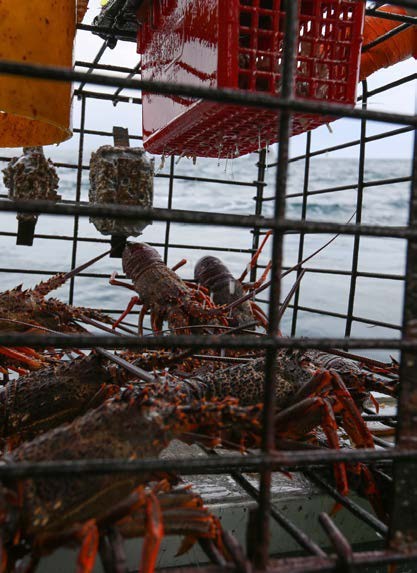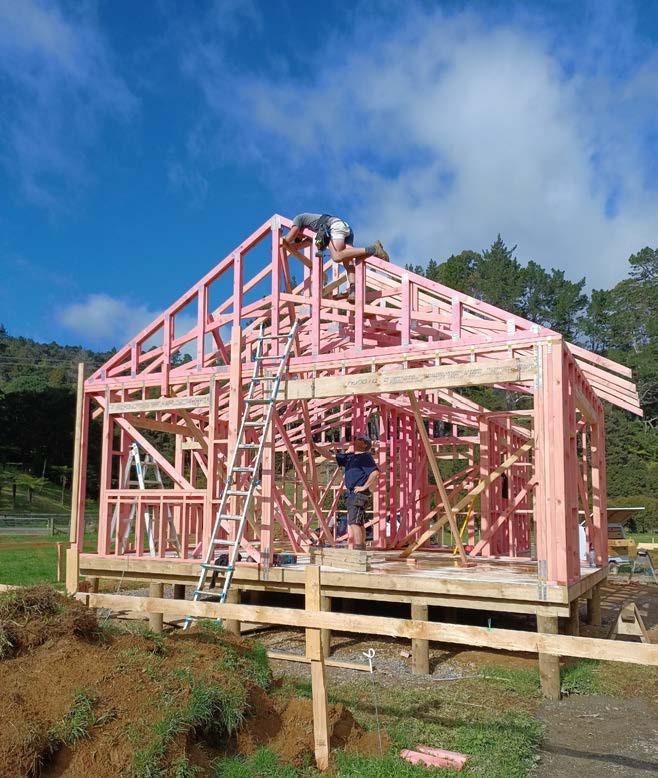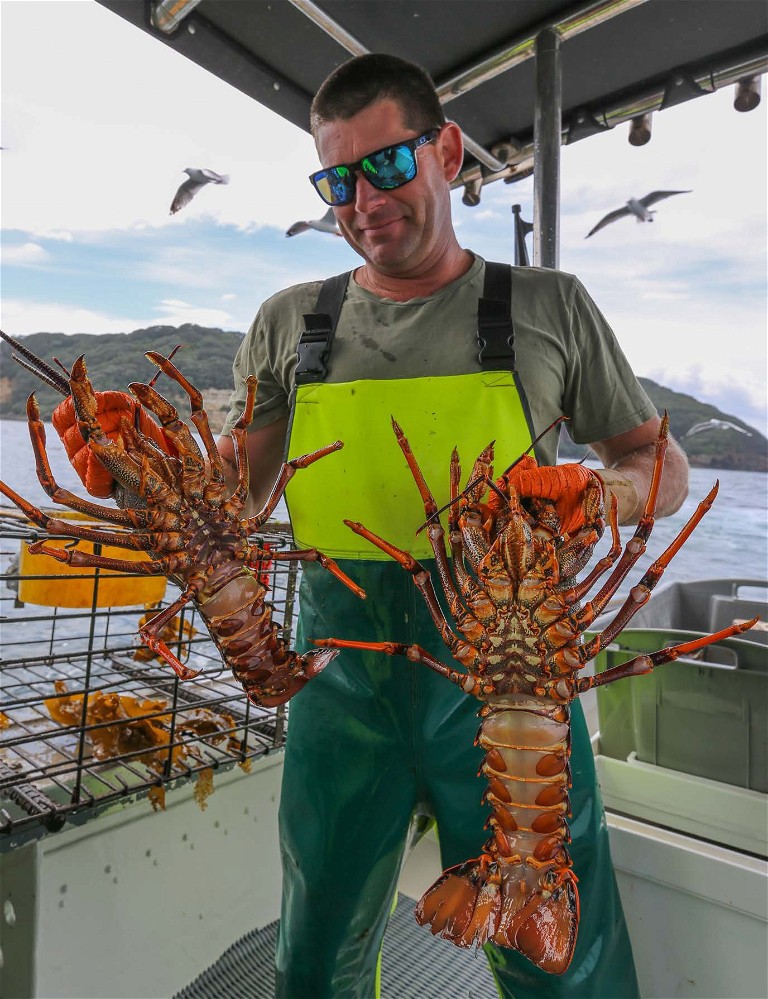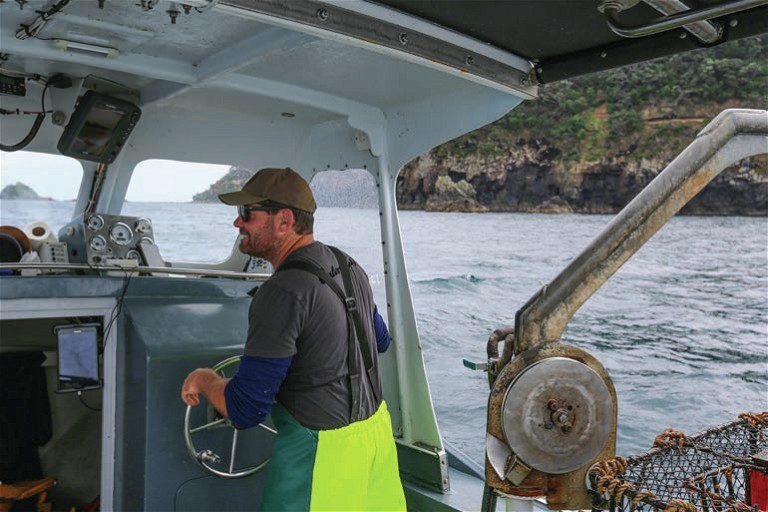AARON & SAMWOOD
THE COLORCOTE TRADIE PROFILE
Words by Nick Jones

Images by Nick Jones
A loud diesel throb breaks the dawn tranquillity of Whitianga Harbour. I’m standing next to stacks of fish bins, brimming with odorous fish frames and barracouta heads. It’s a drizzly, gloomy morning in the Eastern Coromandel, but it doesn’t seem to have dampened the spirit of Aaron and Sam Wood as they swing into the wharf. We make our introductions and the jovial brothers welcome me onboard Wild West, a jetpowered Marlborough that has seen her fair share of days on the briny.
“Here mate, grab some of these,” Aaron says as he offers me a pair of wax earplugs.
“Surely he’s taking the piss,” I think to myself, but when Sam pushes down the throttle upon clearing the harbour, I understand it’s no joke. We head east towards Hahei, hugging the shoreline as we affably yell at each other, sharing stories about recent adventures. Beyond the Cathedral Cove marine reserve, I spy their first string of cray pots, made conspicuous by the industrial-sized buoys bobbing about on the surface.
Aaron and Sam fish commercially for crayfish in the CRA 2 fishery area that stretches from Te Arai north of Auckland down to East Cape. Crayfishing runs through multiple generations of the Wood family. Their grandfather and father both fished for crays, with the latter still making cray pots and getting out on the water to this day.


“ We used to go out fishing with dad as little kids, playing on the roof of the boat and napping in the fish bins if it was a long day! ”
logbook programme, tag and release projects, and sequences of intensive catch sampling to Ministry standards and specifications. On one of our first pots, we bring up a tagged cray, which is carefully measured before being released.
CRA 2 is also one of the few fisheries where the commercial sector has front-footed management measures, voluntarily reducing their catch in 2016 and 2017 to rebuild crayfish numbers. Undoubtedly, the significant proportion of intergenerational fishing families in CRA 2 has helped foster a perspective based on long-term sustainability.
After an hour, we head north towards the Mercury Islands, Wild West tackling the moderate chop with ease. The company, the scenery, and the catch are all consistently good throughout the morning. Cray numbers appear to be healthy along both the coast and the islands – much better than in the early days of Aaron and Sam’s fishing, when catch limits were higher and there were more than half-adozen commercial cray boats working out from Whitianga.
“We have our patch and rotate through our fishing spots – essentially farming the area and never hammering one location,” Sam says.
I take mental notes of the productive shallower spots in case I return to the “We used to go out fishing with dad as little kids, playing on the roof of the boat and napping in the fish bins if it was a long day!” Aaron says.
The rising sun and volcanic cliffs provide a picturesque background for the start of our fishing day. The lads rhythmically get into their work – Sam spinning the boat around on a dime while Aaron hauls the pots, sorts the catch, and launches rebaited pots back into the drink. Sam electronically logs the catch in real-time as they go.
“The CRA 2 fishery has one of the longest-running time series datasets in NZ,” says Sam.
In layperson’s terms, this means that CRA 2 is managed based on solid evidence regarding stock levels. The CRA 2 Rock Lobster Management Company Ltd. (CRAMAC 2) is the representative commercial stakeholder group for this region. CRAMAC 2 has made significant investments in rock lobster research since its formation in 1995, including a comprehensive vessel area with my freediving gear one day. I needn’t bother, though, as the boys are not afraid to share a bit of their hardearned intel: “This a great snorkelling spot to find a feed, Nick; they normally hold in pretty shallow along this ledge.”


I’m impressed by their work ethic, particularly Sam, who has four home-schooled kids!
“ We have our patch and rotate through our fishing spots – essentially farming the area and never hammering one location. ”
We stop for a bite to eat in a sheltered cove on Stanley Island (Kawhitu), catch a couple of bronzed, kelp-coloured snapper on rod and reel, and chat about their tradie backgrounds. Like many crayfishers in NZ, they have a decent ‘off-season’, which Aaron says they spend working on the land as builders.
“Both Sam and I are qualified chippies,” Aaron says. “Our most recent project was building mum’s house.” “We’re looking at upgrading the Wild West to do more fishing – hopefully, with the increase in cray numbers, we will be able to catch a few more soon. But it’s great to still be able to spend some time on the tools and mix it up a bit!”
I’m impressed by their work ethic, particularly Sam, who has four homeschooled kids! Both lads have young boys, and although they have no intention of pushing their offspring into a crayfishing career, I’m sure they’ll be more than happy to show their young fellas the ropes if requested.